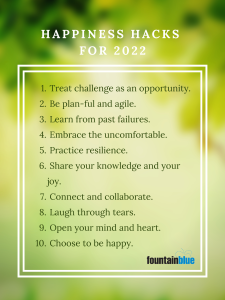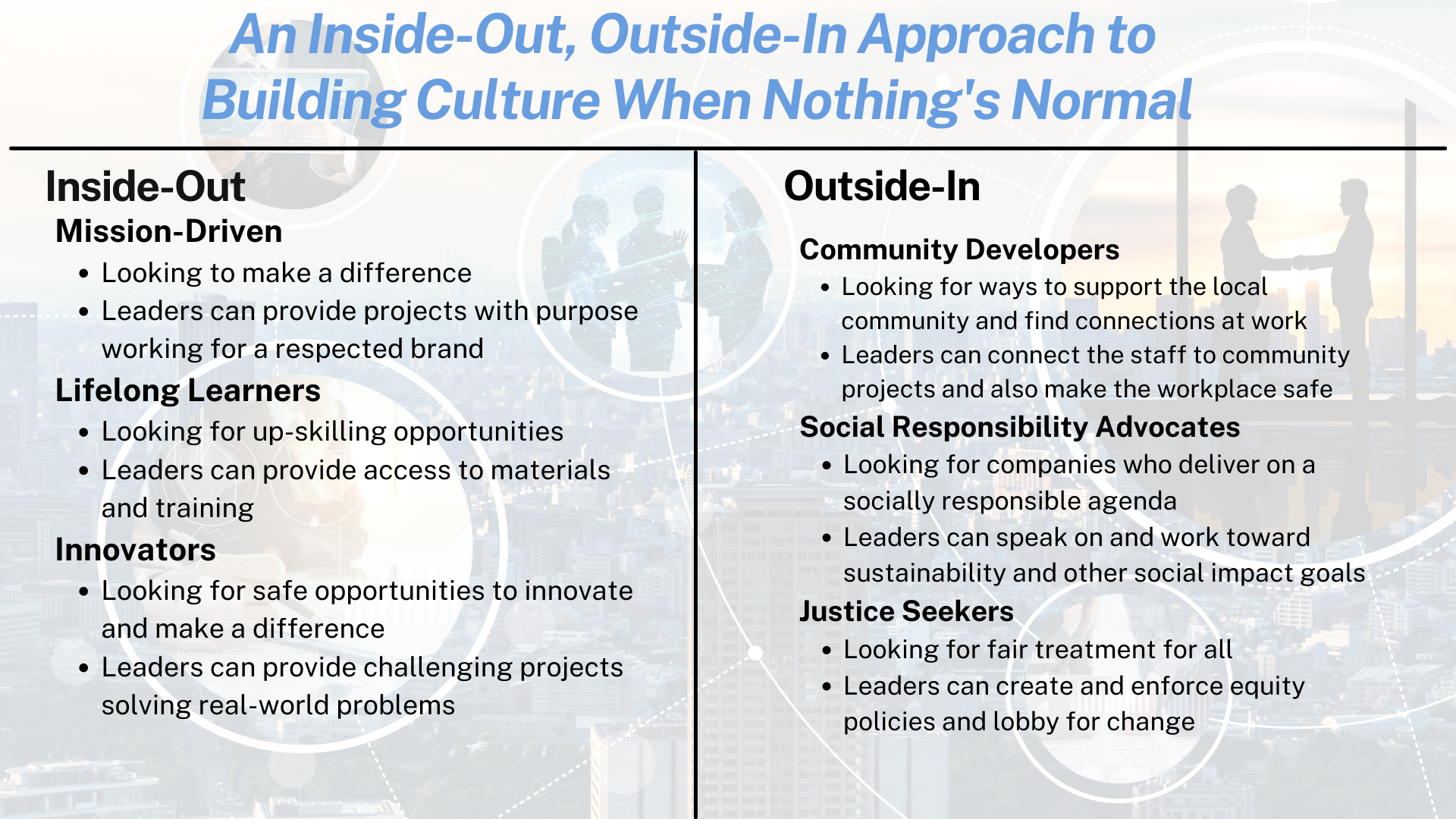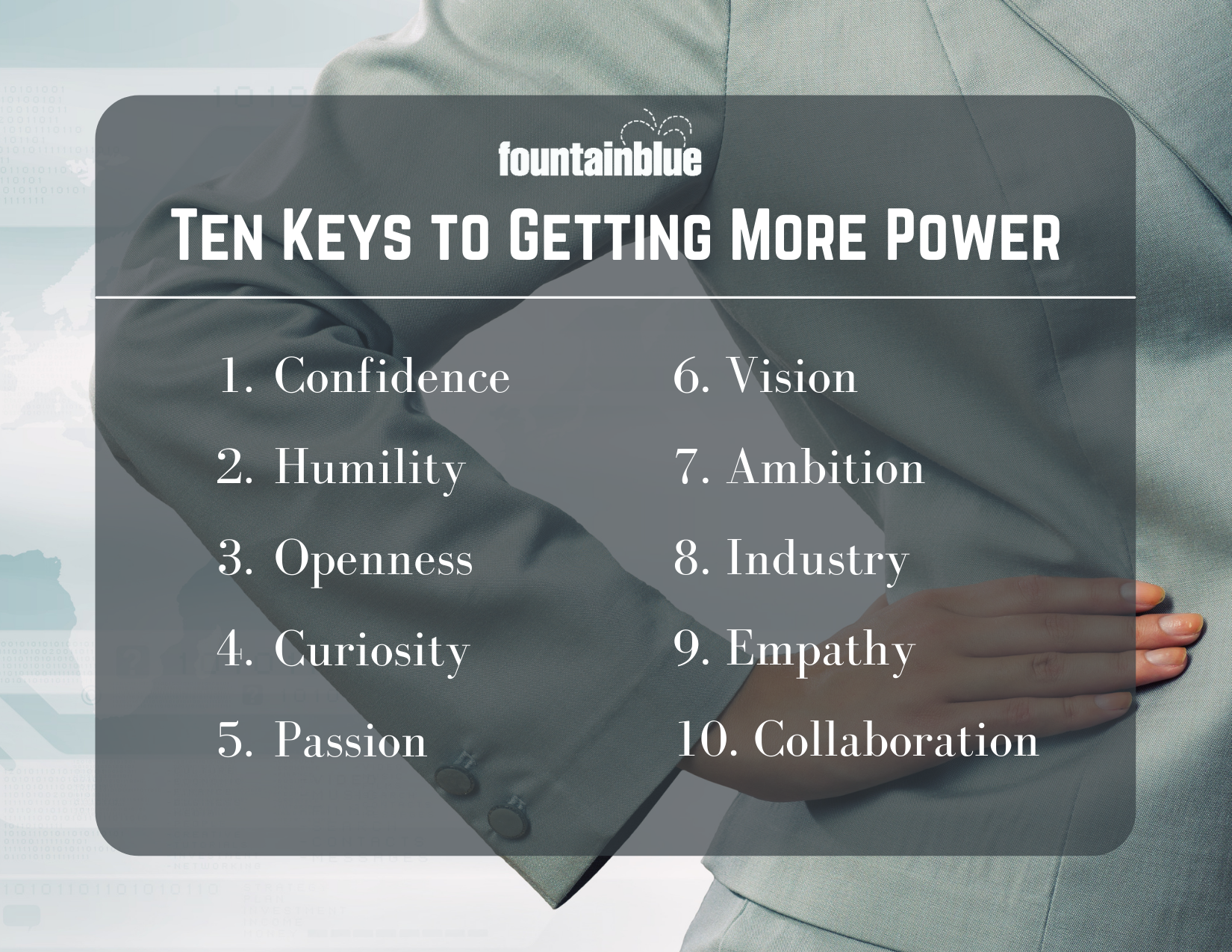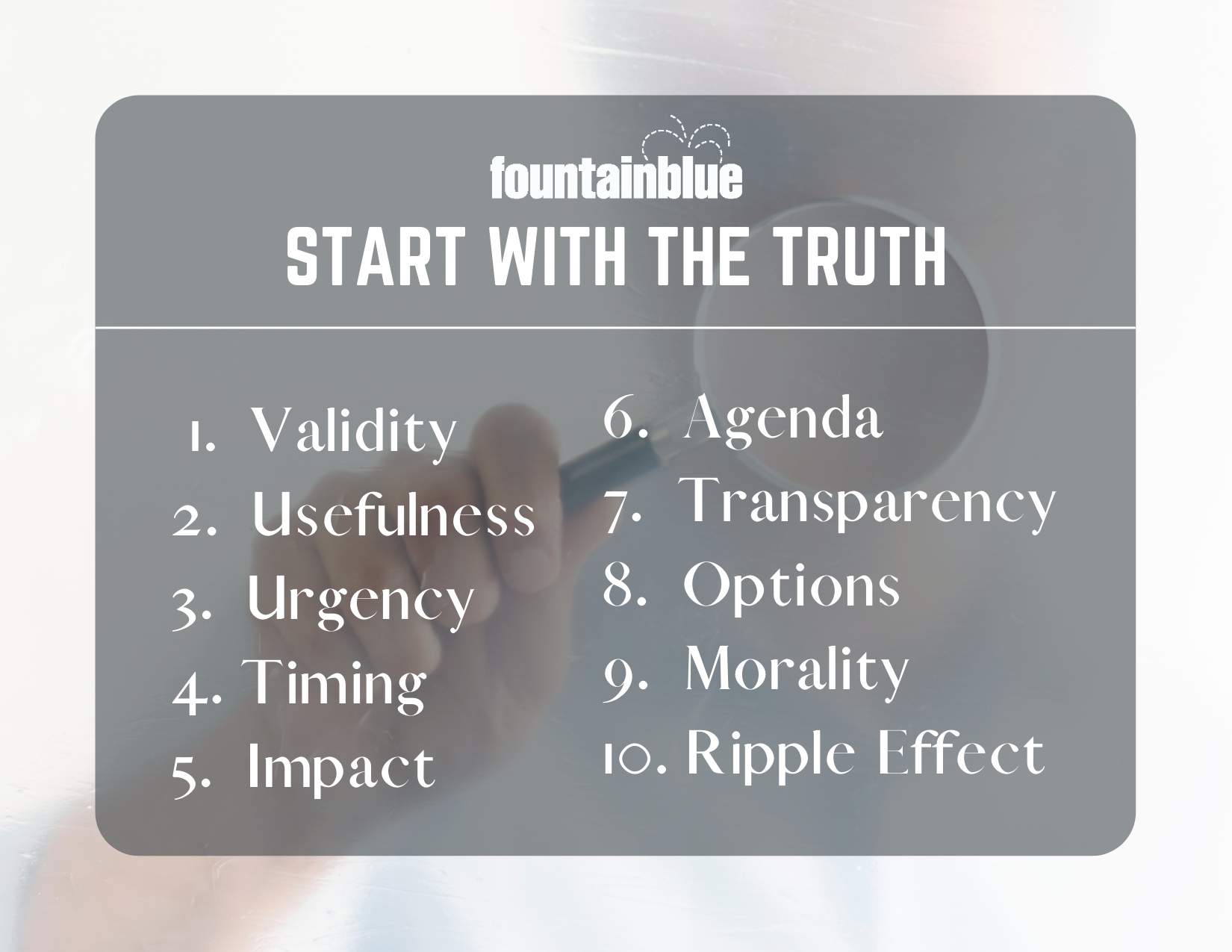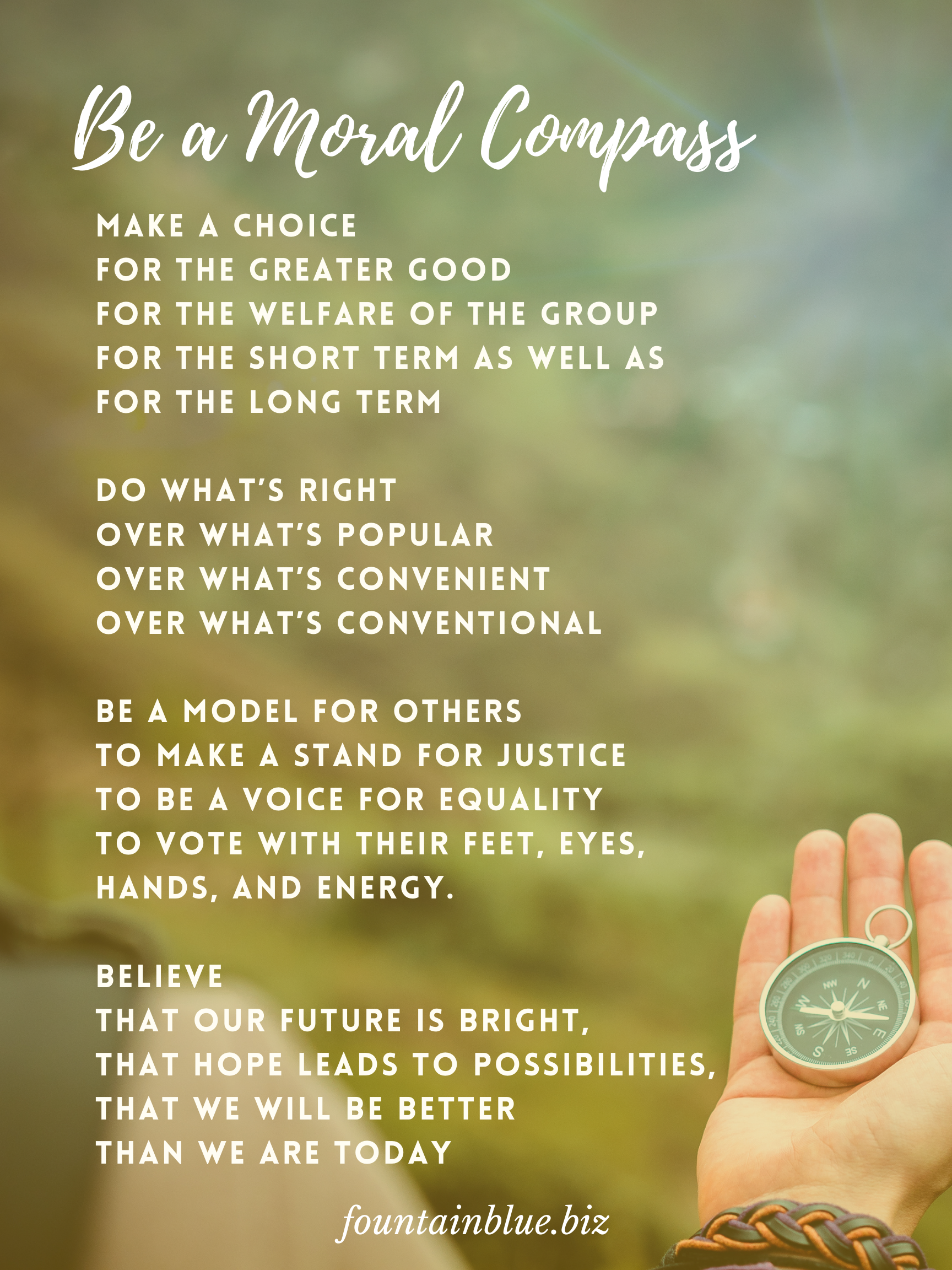
As a change management consultants, FountainBlue provides one-on-one coaching as well as team facilitation and management, with an emphasis on strategic scenario-planning, particularly around digital transformation initiatives.
At FountainBlue, our job is to work with our clients to proactively manage change through strategic facilitation, collaborative scenario-planning, as well as results-driven execution practices.
Strategic Consultation:
1. Evaluate the current situation and desired end state in light of current market, technology and customer trends.
2. Empower the leadership team and key stakeholders to define the strategy and vision.
3. Enlist input and participation from a wide range of stakeholders.
4. Conduct strategic scenario-planning with the intent of optimizing people, processes and results.
Scenario Planning:
5. Integrate strategic goals into operational plans based on a range of scenarios.
6. Facilitate ongoing conversations to ensure alignment between groups and individuals.
7. Ensure access to resources and feedback to enable successful implementation.
8. Encourage and reward strategic problem-solving and decision-making which is collaborative, transparent, and results-oriented.
Results-Based Execution:
9. Create and sustain a growth mindset which embraces failure and invites respectful diversity in thinking, speaking and acting.
10. Invite the input and perspectives of laggards, outliers, skeptics and under-performers while celebrating the successes of leaders, managers, and collaborators.
Envision, Plan, Execute in Collaboration
 With each client project, our emphasis is first on collaborating to articulate a clear strategic vision, next to align all communications to that vision, and then to empower all to execute on the people, process, and operational aspects of that vision.
With each client project, our emphasis is first on collaborating to articulate a clear strategic vision, next to align all communications to that vision, and then to empower all to execute on the people, process, and operational aspects of that vision.
Our strength lies in facilitating an alignment of communication with the vision, enabling dynamic and transparent reports on the progress toward that vision, designing an optimized people- and technology- driven process to operationalize that vision, and collaboratively delivering results which meet or surpass expectations for that vision.
Collaborate to Address People, Process and Metrics Imperatives
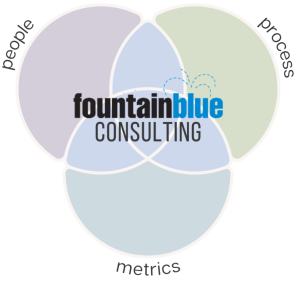 It takes ongoing collaboration to make progress on the people, process and operational goals, and even to re-visit what the vision is!
It takes ongoing collaboration to make progress on the people, process and operational goals, and even to re-visit what the vision is!
- People: Team Building, Leadership Development, Training, Recruitment, Retention, Promotion, Diversity & Inclusion
- Process: IT Integration, HR Applications, Policies, Standards and Compliance,
- Metrics: Management by Objectives (MBOs), Objectives and Key Results (OKRs), Recruitment, Development, Engagement, Promotion and Retention Numbers
 Testimonials and Differentiators
Testimonials and Differentiators
Strategy:
1. Integration of Strategy, Planning and Execution: FountainBlue excels at facilitating a strategic discussion, coordinating planning across teams, and working with all parties to deliver and communicate measurable results.
2. Market and Customer-Driven: FountainBlue centers our strategic conversations around the market opportunities and the current and projected customer needs.
3. Ecosystem Approach: FountainBlue excels at envisioning and creating an ecosystem of stakeholders, and engaging key parties to provide input on the visioning, planning and execution for key projects.
4. Local to Global, Global to Local: FountainBlue facilitates discussions which look both at the market and customer impact as well as the operational and people impact for product and business decisions.
Planning:
5. Innovation-Focused: FountainBlue helps us to focus on the business imperatives around innovation – stretching our technology, solutions, ideas, and creativity to better support our customers.
6. Scenario-Based Facilitation: FountainBlue consistently displays the extraordinary ability to facilitate conversations around scenarios to help us understand the short-term and long-term implications of our decisions and while also engaging stakeholders across the ecosystem in the decision-making process.
7. Collaborative Problem-Solving: FountainBlue excels at bringing all stakeholders to the table to brainstorm alternatives, opportunities and implications to critical business issues.
8. Agile and Iterative Planning: FountainBlue’s ongoing support helps us all be more agile with our planning, more receptive to iterating our vision and plans as scenarios and priorities change for our organization, for our customers, for the market.
Execution
9. Efficient Optimization of People, Process, and Results: FountainBlue ensures that every conversation factors in the people, process and metrics needed to drive progress on goals, as well as alignment of values.
10. Transparent, Inclusive and Direct Communication: Throughout the change management consultation process, FountainBlue worked with us to ensure that our communications were transparent, clear, inclusive, and aligned with our goals, values, and strategies.
Rates and Fees
Our consulting fees are $200/half hour and can range from one-on-one coaching to team coaching, from strategic consultation to meeting facilitation. We can bill for individual sessions, for specific projects, and for ongoing support, with volume discounts upon agreement.
- You and other members from your team can sign up for a complementary 15-minute call to investigate the fit between your current and anticipated needs and the services we provide by visiting https://calendly.com/fountainblue/coaching
- One option for an initial project is two hours of meeting facilitation or strategic consultation which includes a 15-minute planning session, a 15-minute group/executive follow-up meeting, and two one-on-one 15-minute coaching sessions for a fee of $1,000. E-mail us for more details.
- 2 hour meeting
- 2 15-minute pre- and post- planning sessions
- 2 15-minute follow-up coaching sessions
- 3 hours total for discounted rate and fixed fee of $1,000
- Another option for an initial change management consulting contract includes 10 hours of consultation – 2 hours of discovery, 6 hours of collaborative work, and 2 hours of delivery/presentation – for a fixed-price contract of $3000. E-mail us for more details.
 Connect with us and share your digital transformation or change management opportunity and challenge, so we can help you envision, plan and realize What’s Next for yourself, your team and your organization.
Connect with us and share your digital transformation or change management opportunity and challenge, so we can help you envision, plan and realize What’s Next for yourself, your team and your organization.
Respond to some questions below and sign up for a complementary 15-minute call to discover what’s next for you, and how you can step into more influence and impact for your team, your product/service, your organization. https://calendly.com/fountainblue/coaching
- What does your team/organization do (specifically) for whom and why are you better than other options?
- What would your team/organization like to do in your next chapter of your life and career, and how has what you’ve done in the past better positioned you to do it well? What else do you need to do to better prepare you for this next chapter?
- What sectors, companies and leaders should you target, given the above?
- What else would you like to share about yourself, your team/organization, your background, your desired future state?
https://calendly.com/fountainblue/whatsnext
Thank you to all you have participated in our ‘Building Culture When Nothing’s Normal‘ blogs!
Our blogs reflect combined survey results, interviews and community findings as well as the data and information we’ve collected from decades of coaching, leadership development and change management experience, with an emphasis on our findings over the past 18 months.
Redefining ‘Normal’
August 1, 2021
Building Culture When Nothing’s Normal
All the talk has been about the pandemic and how it has been affecting our work and personal lives, as well as how it’s impacting how we do business now and going forward. As the sands keep shifting beneath all of us, independent of gender, race, education, role, and background, we wonder when things will go back to normal and how we can survive and thrive until then.
However, the truth is that some things, including corporate culture, have fundamentally changed, and won’t return to ‘normal’. With that said, there are things that leaders and managers at all levels can do, despite this fact.
This article will be the first chapter for a book I’m writing entitled ‘Building Culture When Nothing’s Normal’. I will release more chapters in upcoming blogs. The book outline is shown at the bottom of the chapter.
For this article, we will pontificate on why things won’t be returning to normal.
- Our shared experience
Never before have we had such a common experience – one which has touched everyone everywhere so deeply, so directly, one that connects us viscerally, while also isolating us unapologetically.
Leaders and managers at all levels must leverage this sense of shared experience to drive engagement, to promote meritocracy, to correct misperceptions, to update policies, processes and procedures, and ultimately to connect more deeply as ONE team with a common purpose.
- Our sense of purpose
Regardless of whether you or your loved ones were directly impacted, the pandemic caused health and welfare issues which helped us all see the fragility and preciousness of life. With that realization, it’s only natural to look at how you’re living your life and whether your day-to-day life choices are in alignment with your values and your life mission. Thus, many are looking at securing more meaningful work that’s in alignment with their values.
As managers and leaders, emphasizing the mission and vision of a company and ensuring that each employee feels like they are contributing to that purpose has become more important than ever.
- Our ability to embrace change
We had to change our habits when the pandemic hit us to meet our minimum basic needs. For some, that meant working from home and ordering everything with no-contact delivery. For others, that meant embracing new technologies, processes, and people.
Leaders and managers at all levels must accept that change is inevitable, and that change will happen much more quickly now. The new standards or ‘normal’ will keep evolving, but it’s a given that rapid change will be an integral part of that evolution.
- Our dependence on technology
Whether we were masters of tech or mere newbies, the pandemic’s made many of us embrace technology at a new level so that we can do our jobs and carry on with our lives. With technology now more ubiquitous than ever, its adoption and advancement will only continue to accelerate.
Managers and leaders at all levels must address the challenge of providing resources and support so that people can efficiently upgrade to more versatile, more powerful, more personalized technology solutions – those which would ideally also respect privacy, access and security protocols.
- Our desire for balance
Gone are the days when we work long hours, depriving ourselves and our loved ones regularly of quality time together. We are willing to work hard, but not as a matter of course, and not exceedingly often.
Leaders and managers must recognize everyone’s need for balancing work and life and provide appropriate compensation and recognition for reasonable hours. Otherwise, they will risk losing employees who highly value a balance between life and work.
- Our focus on efficiency and convenience
Out of necessity, many of us found the most convenient and efficient way to stay safe while also addressing our basic needs – like food, water and safety! We adjusted well to ordering-on-demand and expecting things to be delivered to our doors efficiently.
Managers and leaders must acknowledge this mindset as it will transfer to work. How can we more efficiently provide customized, personalized goods and services to our employees and teams so that they continue to be efficient at work?
- Our drive to deeply connect with others
Humans are social beings, but our desire for social connection varies. Some of us thrived in social isolation. Others of us wilted as social circles shrunk. As more and more people begin to return to in-person work, many have thought deeply about what type of social interactions they’d like to have, with whom, and how frequently.
As leaders and managers, it’s important to recognize these preferences and find ways to ensure bonding and connection within a team or company, despite the wide variance of social connection needs.
- Our respect for science
It’s science that has helped us move beyond the reactive response mode to the logical mode by understanding the mechanisms of the virus and how vaccination can increase our immunity. Recent pandemic-related scientific accomplishments showcased how science and technology can more quickly and effectively address challenging issues.
Managers and leaders must bridge the divide between those who are pro-science/pro-tech and those who might be vaccine hesitant, while also investing in science and technology and research.
- Our interest in justice
Many of us have witnessed the injustices highlighted by the pandemic, the divide between the haves and the have-nots. It forced us to look at what’s just and how to provide more equal opportunities for all.
As leaders and managers, equal opportunity and treatment will be a much higher priority to many.
- Our search for our selves
Many of us have gone on a journey of self awareness, asking ourselves what it’s all about. We have a greater understanding of what we stand for, who and what is important to us, what we need to do to ensure our loved ones feel important, and that our every thought, every word, every action is in alignment with our purpose.
As leaders and managers, we must take an inside-out, outside-in approach to ensure that we meet the needs and objectives of the people who work with and for us.
With our follow-up blog posts, and in our book, I will explain just what I mean by this approach. We welcome corporate managers and leaders at all levels to contribute to our online survey for inclusion in our upcoming blogs.
What do you do when nothing’s normal? How do you plan for the day-to-day, for the future, for what’s next? How do you build a culture when nobody can see the future?
In our August post, we talked about Redefining Normal and followed up by collecting more survey results through phone and online interviews. We’ve combined these findings with the data and information we’ve collected from decades of coaching, leadership development and change management experience, with an emphasis on our findings over the past 18 months.
Indeed, the pandemic and its aftermath has made us all look at what we took for granted as normal, and wrestle with the realization that nothing will ever be normal again.
Yet the Resilient forge on despite the challenges,
and the Successful tap into shared knowledge and networks,
knowing that we are stronger together.
This month, we look more deeply at what leaders can do to build culture when nothing’s normal, exploring a model which takes an inside-out, outside-in approach. We don’t promise you answers, only more questions and updates on our findings so that together we can explore what to do when nothing’s normal.
An Inside-Out Perspective on Building Culture
Inside-Out: In this section, we look from the perspective of the individual, the leader and manager at all levels who sees directly how he/she/they can contribute individually to the culture.
In general, when individuals look through their own personal lens, there are three main motivators:
- The mission-driven calling to work for a purpose, in alignment with their personal values;
- The burning desire for continuous learning and development which makes them better versions of themselves;
- The passionate drive to do something new and bold which innovates and makes the world a better place in ways small and big.
Those who are mission-driven want to contribute in ways big and small to a cause in alignment with their values, a cause larger than one they can serve by themselves, a cause that can be addressed because they show up fully and regularly at work. They must feel like their companies, leaders, technology, and brand are in alignment with this sense of purpose.
To serve the needs of the Mission-Driven staff, leaders at all levels must provide:
- Creation of a Common Platform which matters beyond the work
- Brand Integrity and Authenticity
- A Culture-First Mindset
- Alignment between the Mission, the Vision and the Execution
- Transparency and Authenticity
- Clarity of Purpose in Thoughts, Words and Actions

Those who are Lifelong Learners want to be presented with challenges at work, the opportunity to excel at and learn from these challenges, with a source of light pressure to drive continuous improvement, never settling for mediocrity.
To serve the needs of the Lifelong Learners, leaders at all levels must provide:
- Access to Materials and Training
- Accountability and Ownership
- A Culture of Continuous Learning and Development
- Guidance and Coaching on Educational Plan
- Individualized Offerings
- Rewards for Agility and Openness

Those who are Innovators are motivated by their desires to be creative, solve problems, and work on a variety of challenging tasks which make a difference. They are hungry for a fail-forward mindset and culture, as well as tangible opportunities to innovate and learn with the support of mentors, resources and the organization at large.
To serve the needs of Innovators, leaders at all levels must provide:
- Access to Mentors, Sponsors and Resources
- Assurance that Credit is Fairly Distributed
- Focus on Customer-driven Innovation Projects
- Diversity of Perspectives and Experiences on Team
- Inspiring Examples and Success Stories
- Rewards for Innovative Ideas and Execution

An Outside-In Perspective on Building Culture
Outside-In: In this section, we look from the perspective of the leader or manager at any level, on what managers and leaders from any chair can do to facilitate the development of an organization’s culture.
In general, when individuals look through the lens of the team, organization, or community, there are three main motivators:
- The socially-minded desire to connect with and trust in others. They crave a co created history along with traditions and continued progress toward common goals and including celebrations of success;
- The burning desire to leverage corporate influence and resources to collectively impact larger social, political, and environmental issues;
- The passionate drive to advocate and lobby for more equitable rights, resources and opportunities for those less fortunate, less empowered and less enabled to succeed.
Those who are Community-Builders are motivated by the desire to create a safe, trusted and synergistic network focused on everything from developing and supporting each other to creating deep relationships and from providing empathy, camaraderie, fun and energy to working as a team to deliver extraordinary results. Community-Builders are looking for a sense of belonging, a trusted and supportive network, and for opportunities to share experiences, celebrations and traditions together.
To serve the needs of Community-Builders, leaders at all levels must provide:
- A Positive and Productive Culture which Celebrates Success
- Clear Accountability and Metrics
- Resources and Support to Achieve Results
- Sense of Fit and Belonging
- Connections between Community Groups and Members

Those who are Social Responsibility Advocates are motivated by the desire to leverage company resources and brand to deliver impact on social, environmental, and systemic challenges, to provide services to others in need, and to provide socially responsible leadership and financial support. The corporate platform and brand provides opportunities to make a broader impact in many ways, including by serving the needs of local nonprofits, by supporting the fundraising efforts around climate change, or by providing resources for the disadvantaged.
To serve the needs of Social Responsibility Advocates, leaders at all levels must provide:
- Partnerships and Ecosystems to Amplify Impact
- Platform to Amplify Impact and Share Knowledge
- Opportunities to Serve Social Causes of Interest
- Alignment between Corporate Mission and Social Causes Supported
- Respect and Support for the Daunting Challenges of Today

Those who are Justice-Seekers are motivated by the desire to to witness equal opportunities around pay, recognition, and opportunity for all. Justice-Seekers would like to see open-minded leaders who respect and embrace diverse people in their thoughts, words and actions. Transparent, data-based conversations will help justice-seekers see the progress being made, and respect their leaders and organization overall.
To serve the needs of Justice-Seekers, leaders at all levels must provide:
- Alignment on Values, Policies and Communications
- Equal access to Support, Coaching, Education and Resources
- Systematic Approaches to the Recruitment, Retention and Advancement of Diverse Talent
- Training on Unconscious Biases
- Celebrate and Reward Diverse Thinking and Ideas
- Transparent and Regular Reporting on progress to date

Bringing it Together:
Whether you look through the lens of what you can do as an individual to shape culture personally, or look through the lens of the organization as a whole, take ownership and focus on making a difference, through the conscious choice to evolve the culture, consistently and relentlessly.
Next month, we will create a how-to blog around building culture. As we continue to develop our content in Building Culture When Nothing’s Normal, your input is welcome through our survey, e-mail, or an interactive conversation.
October 2021: Raising the Bar for Morality
 In October, I spoke on the topic of ‘Corporate Citizenship, Ethics and Morality’ when nothing’s normal to a group of senior HR executives. This is an important topic as nobody can rely on laws and regulations for each scenario, and decision-making relies on the use of good judgment and high moral standards.
In October, I spoke on the topic of ‘Corporate Citizenship, Ethics and Morality’ when nothing’s normal to a group of senior HR executives. This is an important topic as nobody can rely on laws and regulations for each scenario, and decision-making relies on the use of good judgment and high moral standards.

I’ll frame my remarks based on Lawrence Kohlberg’s six stages of moral development.* Although Kohlberg’s research was about how children develop their sense of morality and justice based on moral dilemmas**, I believe that it has deep implications for the corporate world.
What’s relevant are the corporate use cases around doing the right thing. Relevant use cases for today include the below:
- Outsourcing your work
- Taking credit for someone else’s work
- Promotion, bonus and hiring practices
- Resource allocation
- Project assignment
These issues have been with leaders since we first started gathering in groups, but with today’s war for talent, with the focus on retaining, growing, and promoting the most qualified and engaged talent, with the new definition of normal, the stakes become much higher.
Laws and precedence and short-term rewards aren’t sufficient guidelines on how to make ethical, proactive choices. Below is a framework to consider as you evaluate the options for each moral dilemma.
- Is it the truth? How do you know it’s the truth? Don’t act without knowing the truth…
- Are all parties being transparent about what’s true? Insist on transparency in most cases…
- Would it be helpful to share the truth? Sometimes, the truth is better not shared…
- Is it the right time to share this truth?
- What are the best options for being firm (but kind), fair, and consistent? You don’t have to be the person who implements the best options…
- What is the morality/ethics of the dilemma given the best options available?
- What is the ripple effect for decisions made on culture, brand, relationships, business, etc.,?
Making the right choices on ethics, morality and civility is the responsibility of people at all levels every day – not just the responsibility of senior executives and not just sometimes. Therefore, it’s everyone’s responsibility to step up and speak out, to err on the side of doing the right thing, for every transgression or injustice ignored is an implied approval…
What we each think, say and do has implications for others. Doing the right thing for the business, for the people, may not present the recognition and reward you’re seeking, but it may raise the bar for civility, morality, and culture. And this is a good thing.
* The Philosophy of Moral Development: Moral Stages and the Idea of Justice (Essays on Moral Development, Volume 1) Hardcover – July 1, 1981 https://www.amazon.com/Philosophy-Moral-Development-Stages-Justice/dp/0060647604
**Kohlberg Dilemmas http://ww3.haverford.edu/psychology/ddavis/p109g/kohlberg.dilemmas.html
November 2021: What is Truth?

What is Truth?
‘Truth is the Foundation of Culture’, I said in our October 2021 talk about Morality, Ethics and Civic Responsibility. But why is that the case, and HOW do we insist on getting to a valid truth?
Why is Truth the Foundation of Culture?
-
Many of the conscious thoughts, words and actions we make are based on the truth we have at the moment.
-
Understanding WHY we create these thoughts, words and actions will help us either perpetuate our ways of being or shift them entirely.
-
Focusing on the truth of a technology and its potential will help everyone be more productive, focused and innovative.
-
When we respond to mis-information, and the truth comes out, there will likely be a fall-out which negatively impacts people, processes, products, as well as brand, momentum and credibility. (On rare occasions, there will be a positive impact, but that’s generally unintentional and random, even if it’s serendipitous.)
-
Perpetuating bold mis-information which becomes widely adopted can lead to a culture that rewards additional mis-information, undermines trust, promotes the corrupt, and dis-empowers the outspoken.
What Can We Do to Validate the Truth?
-
First, respect that the truth impacts everyone and everything. Insist on a high standard of what is adopted as the truth.
-
Consider the source of the data and the validity of what’s being measured.
-
Focus on the data behind the truth, and how knowing the data and the truth would benefit others.
-
Consider the motivations of the various stakeholders and how they might influence the data or the truth.
-
Empower everyone to continuously insist on thinking, speaking, and acting on the truth, even when it’s uncomfortable to do so.
The bottom line is that leaders at all levels can build a solid foundation for culture if they can align on validated statements of truth and take actions based on that truth.
Start with the Truth, December 2021
Over the past month, there have been many questions and conversations around truth. Indeed, whether the coaching, advising or consulting questions were around decision-making or problem-solving, innovation or engagement, retention or conflict resolution, truth was the foundational step toward progress. I have therefore summarized a list of criteria to guide the search for truth. I hope that you find it useful.
- Validity:
- What is the data and how do you know that it reflects past, current and projected conditions?
- Usefulness:
- Would it be helpful to share the truth? If so, which people and groups would benefit (or not) and why?
- Urgency:
- Is there an urgent need to take action on the truth? If so, why so and which groups or people are urgently impacted?
- Timing:
- If there’s not an urgent need, when *is* the right time to share this truth and to which people or groups and why?
- Impact:
- Who is impacted by the truth? How would you communicate the truth to the different groups of impacted people?
- Agendas:
- What are the motivations of the parties sharing information? How would their motivations taint what they portray to be true? How would the truth support them in achieving their goals?
- Transparency:
- Are all parties being transparent about what’s true? Will you be communicating the full truth to all parties? Why or why not?
- Options:
- What are the best options for being firm but kind and fair but consistent?
- Morality:
- What are the moral, legal and ethical issues of the dilemma, given the best options available for responding to the truth?
- Ripple Effect:
- What are the ripple effects of the actions taken on culture, brand, relationships, business, etc.,?
What are your thoughts? How can focusing on the truth support yourself and your team in reaching corporate and cultural objectives?
Inspirational Messages
 We are writing monthly messages around the next normal. Please feel free to print and frame our messages below, with full credit to FountainBlue.
We are writing monthly messages around the next normal. Please feel free to print and frame our messages below, with full credit to FountainBlue.
MESSAGES of HOPE for the Next Normal
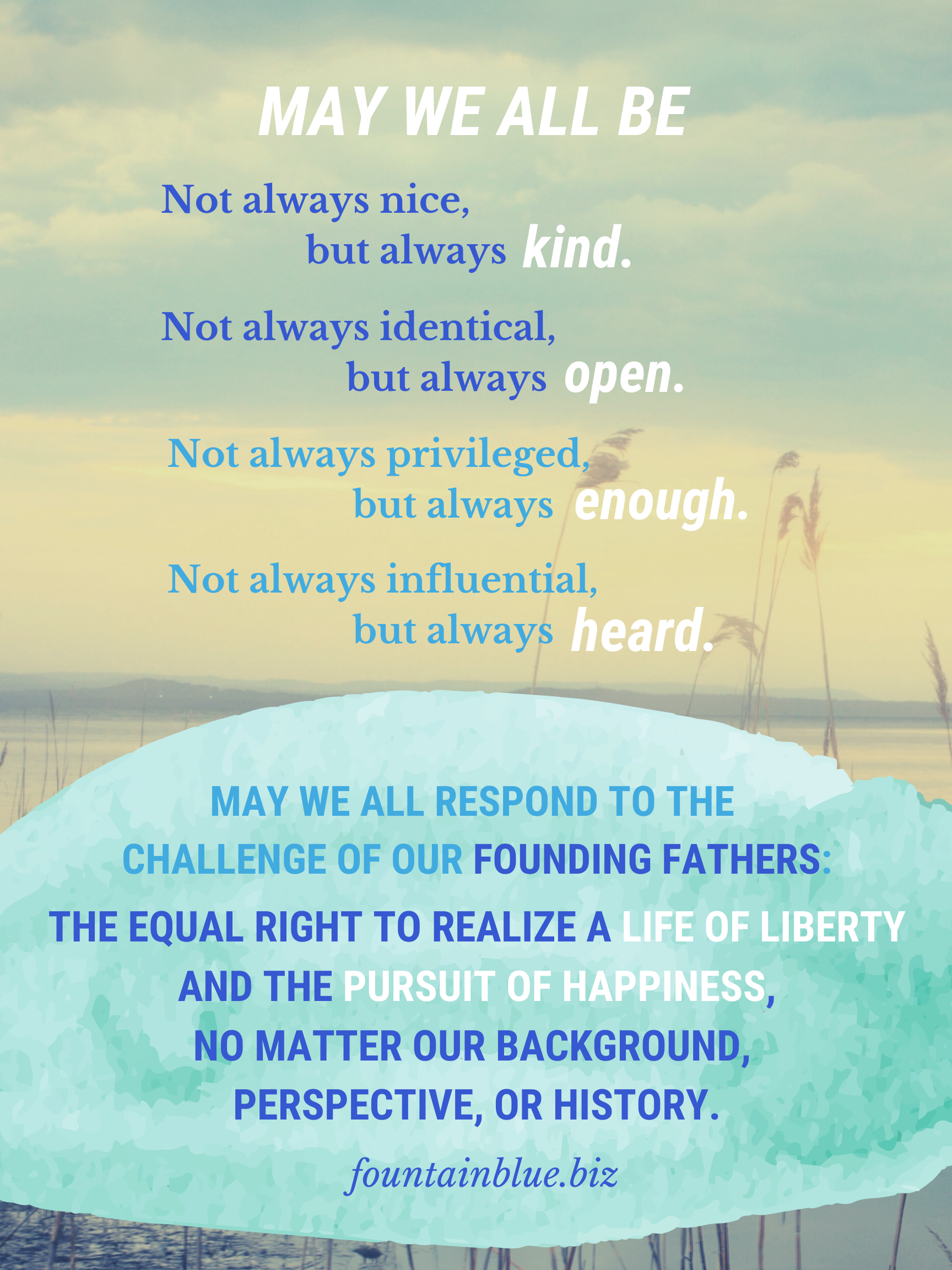 January 31, 2021: May we all BE:
January 31, 2021: May we all BE:
Not always nice, but always KIND.
Not always identical, but always OPEN.
Not always privileged, but always ENOUGH.
Not always influential, but always HEARD.
May we all respond to the challenge of our founding fathers:
The EQUAL right to realize a LIFE of LIBERTY,
in the PURSUIT of HAPPINESS,
No matter our background, our perspectives, our history.
Be a Moral Compass,
by Linda Holroyd, February 2021

